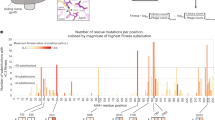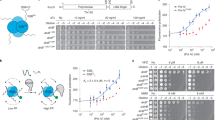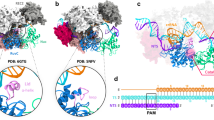Abstract
In processive catalysis, a catalyst binds to a substrate and remains bound as it performs several consecutive reactions, as exemplified by DNA polymerases. Processivity is essential in nature and is often mediated by a clamp-like structure that physically tethers the catalyst to its (polymeric) template. In the case of the bacteriophage T4 replisome, a dedicated clamp protein acts as a processivity mediator by encircling DNA and subsequently recruiting its polymerase. Here we use this DNA-binding protein to construct a biohybrid catalyst. Conjugation of the clamp protein to a chemical catalyst with sequence-specific oxidation behaviour formed a catalytic clamp that can be loaded onto a DNA plasmid. The catalytic activity of the biohybrid catalyst was visualized using a procedure based on an atomic force microscopy method that detects and spatially locates oxidized sites in DNA. Varying the experimental conditions enabled switching between processive and distributive catalysis and influencing the sliding direction of this rotaxane-like catalyst.
This is a preview of subscription content, access via your institution
Access options
Subscribe to this journal
Receive 12 print issues and online access
$259.00 per year
only $21.58 per issue
Buy this article
- Purchase on Springer Link
- Instant access to full article PDF
Prices may be subject to local taxes which are calculated during checkout





Similar content being viewed by others
Change history
26 September 2013
In the version of this Article originally published online, the co-author Tom G. Bloemberg should have been included in affiliation 1 as well as 2. This has now been corrected in all versions of the Article.
References
Breyer, W. A. & Matthews, B. W. A structural basis for processivity. Protein Sci. 10, 1699–1711 (2001).
Stillman, B. Smart machines at the DNA-replication fork. Cell 78, 725–728 (1994).
Kovall, R. & Matthews, B. W. Toroidal structure of λ-exonuclease. Science 277, 1824–1827 (1997).
Benkovic, S. J., Valentine, A. M., & Salinas, F. Replisome-mediated DNA replication. Annu. Rev. Biochem. 70, 181–208 (2001).
Champoux, J. J. DNA topoisomerases: structure, function, and mechanism. Annu. Rev. Biochem. 70, 369–413 (2001).
López de Saro, F. J., Georgescu, R. E. & O'Donnell, M. A peptide switch regulates DNA polymerase processivity. Proc. Natl Acad. Sci. USA 100, 14689–14694 (2003).
Indiani, C., McInerney, P., Georgescu, R., Goodman, M. F & O'Donnell, M. A sliding-clamp toolbelt binds high- and low-fidelity DNA polymerases simultaneously. Mol. Cell 19, 805–815 (2005).
Trakselis, M. A., Alley, S. C., Abel-Santos, E. & Benkovic, S. J. Creating a dynamic picture of the sliding clamp during T4 DNA polymerase holoenzyme assembly by using fluorescence resonance energy transfer. Proc. Natl Acad. Sci. USA 98, 8368–8375 (2001).
Yang, J., Zhuang, Z., Roccasecca, R. M., Trakselis, M. A. & Benkovic, S. J. The dynamic processivity of the T4 DNA polymerase during replication. Proc. Natl Acad. Sci. USA 101, 8289–8294 (2004).
Breslow, R. Artificial enzymes. Science 218, 532–537 (1982).
Murakami, Y., Kikuchi, J., Hisaeda, Y. & Hayashida, O. Artificial enzymes. Chem. Rev. 96, 721–758 (1996).
Nanda, V. & Koder, R. L. Designing artificial enzymes by intuition and computation. Nature Chem. 2, 15–24 (2010).
Takashima, Y., Osaki, M., Ishimaru, Y., Yamaguchi, H. & Harada, A. Artificial molecular clamp: a novel device for synthetic polymerases. Angew. Chem. Int. Ed. 50, 7524–7528 (2011).
Thordarson, P., Bijsterveld, E. J., Rowan, A. E. & Nolte, R. J. Epoxidation of polybutadiene by a topologically linked catalyst. Nature 424, 915–918 (2003).
Coumans, R. G. E., Elemans, J., Nolte, R. J. M. & Rowan, A. E. Processive enzyme mimic: kinetics and thermodynamics of the threading and sliding process. Proc. Natl Acad. Sci. USA 103, 19647–19651 (2006).
Monnereau, C. et al. Porphyrin macrocyclic catalysts for the processive oxidation of polymer substrates. J. Am. Chem. Soc. 132, 1529–1531 (2010).
Meunier, B. Metalloporphyrins as versatile catalysts for oxidation reactions and oxidative DNA cleavage. Chem. Rev. 92, 1411–1456 (1992).
Pratviel, G., Bernadou, J. & Meunier, B. DNA and RNA cleavage by metal complexes. Adv. Inorg. Chem. 45, 251–312 (1998).
Bernadou, J. & Meunier, B. Biomimetic chemical catalysts in the oxidative activation of drugs. Adv. Synth. Catal. 346, 171–184 (2004).
Berdis, A., Soumillion, P. & Benkovic, S. The carboxyl terminus of the bacteriophage T4 DNA polymerase is required for holoenzyme complex formation. Proc. Natl Acad. Sci. USA 93, 12822–12827 (1996).
Zhuang, Z. H., Berdis, A. J. & Benkovic, S. J. An alternative clamp loading pathway via the T4 clamp loader gp44/62–DNA complex. Biochemistry 45, 7976–7989 (2006).
Smiley, R. D., Zhuang, Z. H., Benkovic, S. J. & Hammes, G. G. Single-molecule investigation of the T4 bacteriophage DNA polymerase holoenzyme: multiple pathways of holoenzyme formation. 45, 7990–7997 (2006).
Vologodskii, A. V., Lukashin, A. V., Anshelevich, V. V. & Frank-Kamenetskii, M. D. Fluctuations in superhelical DNA. Nucleic Acids Res. 6, 967–982 (1979).
Freifeld, D. & Trumbo, B. Matching of single-strand breaks to form double-strand breaks in DNA. Biopolymers 7, 681–693 (1969).
Pratviel, G., Duarte, V., Bernadou, J. & Meunier, B. Nonenzymic cleavage and ligation of DNA at a three A•T base pair site. A two-step pseudohydrolysis of DNA. J. Am. Chem. Soc. 115, 7939–7943 (1993).
Neish, C. S., Martin, I. L., Henderson, R. M. & Edwardson, J. M. Direct visualization of ligand–protein interactions using atomic force microscopy. Br. J. Pharmacol. 135, 1943–1950 (2002).
Alley, S. C., Abel-Santos, E. & Benkovic, S. J. Tracking sliding clamp opening and closing during bacteriophage T4 DNA polymerase holoenzyme assembly. Biochemistry 39, 3076–3090 (2000).
Jarvis, T. C., Paul, L. S., Hockensmith, J. W. & Von Hippel, P. H. Structural and enzymatic studies of the T4 DNA replication system. II. ATPase properties of the polymerase accessory protein complex. J. Biol. Chem. 264, 12717–12729 (1989).
Heiter, D. F., Lunnen, K. D. & Wilson, G. G. Site-specific DNA-nicking mutants of the heterodimeric restriction endonuclease R.BbvCI. J. Mol. Biol. 348, 631–640 (2005).
Nakamura, J. et al. Highly sensitive apurinic/apyrimidinic site assay can detect spontaneous and chemically induced depurination under physiological conditions. Cancer Res. 58, 222–225 (1998).
Acknowledgements
We thank M. M. Spiering and Z. Zhuang for their assistance and for useful discussions. We thank M. B. Castells and D. van de Mosselaar for synthetic assistance. This work was supported by the Royal Netherlands Academy of Arts and Sciences (R.J.M.N.), NWO Vici (A.E.R.), a research grant from the European Research Council (ERC-2011-AdG 290886 ALPROS to S.F.M.v.D. and R.J.M.N.) and finance from the Dutch Ministry of Education, Culture and Science (Gravity program 024.001.035).
Author information
Authors and Affiliations
Contributions
S.J.B. and R.J.M.N. conceived the experiments and A.E.R., R.J.M.N., S.F.M.v.D. and J.C. designed the experiments. J.C. performed the experimental work and was supervised by J.J.L.M.C. K.N. developed the AFM-analysis. M.A.T. and S.W.N. provided expertise on protein design and expression. T.G.B. performed statistical analysis. S.F.M.v.D. performed additional experimental work. J.C., S.F.M.v.D., K.N., T.G.B., A.E.R. and R.J.M.N. analysed and interpreted the results. S.F.M.v.D. and J.C. co-wrote the manuscript and S.J.B., A.E.R., R.J.M.N., K.N., M.A.T., S.W.N. and T.G.B. commented on it.
Corresponding authors
Ethics declarations
Competing interests
The authors declare no competing financial interests.
Supplementary information
Supplementary information
Supplementary information (PDF 1629 kb)
Rights and permissions
About this article
Cite this article
van Dongen, S., Clerx, J., Nørgaard, K. et al. A clamp-like biohybrid catalyst for DNA oxidation. Nature Chem 5, 945–951 (2013). https://doi.org/10.1038/nchem.1752
Received:
Accepted:
Published:
Issue Date:
DOI: https://doi.org/10.1038/nchem.1752
This article is cited by
-
Ru(II)Porphyrinate-based molecular nanoreactor for carbene insertion reactions and quantitative formation of rotaxanes by active-metal-template syntheses
Nature Communications (2020)
-
Catalytic transport of molecular cargo using diffusive binding along a polymer track
Nature Chemistry (2019)
-
An artificial molecular machine that builds an asymmetric catalyst
Nature Nanotechnology (2018)
-
Encoding information into polymers
Nature Reviews Chemistry (2018)
-
Molecular machines for catalysis
Nature Reviews Chemistry (2018)



